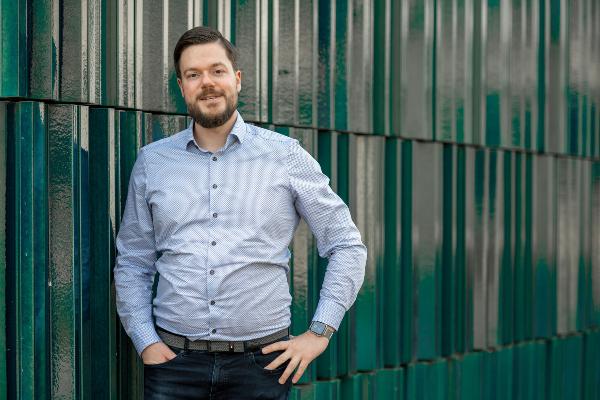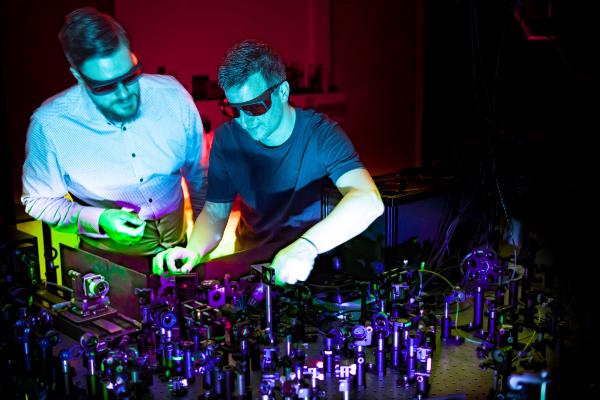In the nanometer range (billionth of a meter), interactions occur between light and matter that do not happen on larger scales. As such, so-called nanophotonic materials have unique optical properties that open up a whole range of technical possibilities. Researchers led by Andreas Tittl, Professor of Experimental Physics at LMU, have now developed a method that permits the manufacture of extremely thin optical components that react strongly to even comparatively weak light. “In the future, these thin components could pave the way for tiny, more sensitive sensors, more energy-efficient computer components, and faster optical communication,” says Tittl. The team has reported on their method in the journal Nature Photonics.
The nanophotonic materials used are based on so-called metasurfaces, which have regular patterns that are generally smaller than the wavelengths of light. Photonic resonator is the name given to these tiny structures in the nanometer range, which are capable of altering the amplitude, phase, and polarization of incident electromagnetic waves, including light. With suitable metasurfaces, therefore, it is possible to precisely control – to store, say, or amplify or extinguish – light beams.
Nanophotonics: coupling light and matter
Read more
In a first, the researchers led by Tittl have now integrated the concept of metasurfaces into multilayered 2D materials whose individual layers can consist of just one or two, atomic sheets. “The best known 2D material is graphene, but actually there are quite a number of other ones now available,” says Tittl. “You can buy these materials in crystal form, remove individual layers under the microscope, and stack them kind of like paper.” In this way, you can precisely control their atomic arrangement and obtain materials with strong in-plain covalent bonding and weak interlayer interactions. Experts refer to these as van der Waals materials, and they are an important focus of modern materials research.
Combining concepts
However: “Before now, the literature stopped at macroscopic stacks of multiple 2D materials,” explains Tittl. His group utilized an additional nanolithographic process to add further structural parameters to the van der Waals stack, which amplify the light-matter interactions as on a metasurface. “And so, instead of placing 2D materials on separate, ready-made nanostructures or using bulky external optical resonators, we worked the resonance structure directly into the vdW stack,” says Tittl. The researchers named the components created in this way “van der Waals heterostructure metasurfaces” – or vdW-HMs for short.
Specifically, the team, in collaboration with researchers from a group led by Prof. Achim Hartschuh at the Technical University of Munich, packed an individual semiconducting layer of tungsten disulfide, WS2, between several protective layers of hexagonal boron nitride. Using a lithographic technique, the researchers then worked periodic structures into this material stack, with which light interacts efficiently: The electrons in the material are excited by the incident light and coupled to the light particles (photons). Experts call these hybrid light-matter particles “exciton-polaritons”. They have both material and light-like properties and can condense – similar to a Bose-Einstein condensate, an extreme state of matter in which the vast majority of the particles exist in the same quantum mechanical state.
Resonators that capture light very efficiently
To obtain the highest possible interaction between light and matter and control unwanted diffraction, the researchers carried out theoretical modeling and simulation. They were thus able to optimize the vdW-HMs and ended up with nanophotonic components that reacted even to light intensities over 1,000 times lower than previously reported. “Essentially, we’ve developed ultrathin resonators that capture light very efficiently so that we can use it,” explains Luca Sortino, a member of Tittl’s team and lead author of the study.
Moreover: “We’ve now got a toolkit, so to speak, for combining the two materials science concepts and extending this model to many other 2D materials,” says Sortino. And so it would be possible to develop various nanophotonic components with customized optoelectronic characteristics. The researchers are now planning to further investigate this potential, reveals Sortino.
They hope the vdW-HMs will facilitate the development of ultrathin, flat optical components with new functionalities. Potential applications include, for example, fast optical switches, neuromorphic computing, so-called polariton lasers, which could potentially be built directly into chips, and novel platforms for researching quantum phenomena.


